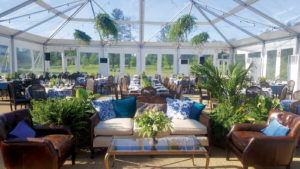
Cooling technology for event tents helps to ensure that guests stay in their comfort zone.
The flexibility of tented environments has always been a selling point for party and event rental companies. Knowing that their event will take place under a properly cooled or heated tent offers clients peace of mind, regardless of a rising or falling mercury.
While fans and air conditioners are the standbys for cooling, options such as evaporative coolers, heat exchangers and misting machines offer additional strategies for effective climate control and guest comfort. In addition, seasonal heat has different qualities in different geographical markets, requiring different solutions. The muggy, stifling heat of late August in the upper Midwest is different than the dry, scorching heat of Phoenix, Ariz. A plan that efficiently combines appropriate equipment, layout and effective operation helps tents to stay cool at a reasonable cost.
What are the choices?
Creating a comfortable tented environment begins with using the right equipment, which can range from simple pedestal or tent pole fans to full-on air conditioning units. One option is the heat pump.
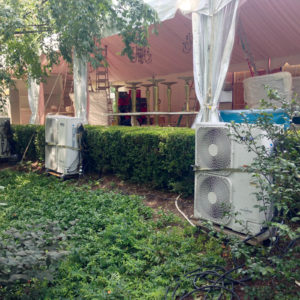
“We primarily use heat pumps for both heating and cooling,” says Tina Behnke, business development director for AirPac® Inc., a renter of portable air conditioning and heating equipment based in Front Royal, Va. The heat pumps require a minimal footprint in tented spaces, making them more flexible in terms of placement, and they work in any style oftent, she says.
“We use no ductwork,” Behnke says. “Our units are modular and split system, with an indoor handling unit and outdoor condensing unit that are connected.”
Expansion cooling units are another option. “Our most popular item is a [direct expansion] cooling system,” says Wade Sorenson, president of Flagro USA Inc., a supplier of heating and cooling equipment for the construction and rental industries based in Savage, Minn. “There are vertical and horizontal direct expansion units. Vertical units replace a tent wall on tents. This allows both the cooling and returns in a small footprint. Horizontal units are set away from the tent with ducts running to the tent to provide cooling and return.”
Based in Sauk Rapids, Minn., Pinnacle Climate Technologies™ offers an array of ventilation equipment for the rental market under its Schaeffer and Master brands, including fans, misting fans, evaporative coolers and portable air conditioning units.
White tent fans are a top selling cooling item, says Pinnacle rental national sales manager Kate Boland. “They blend in with the tent so well,” she says. “[They] have a low amp draw, which makes them popular as well. You can plug in many of them to one circuit.”
What’s the forecast?
Regional and seasonal differences underscore the need for accurate system estimating. An underperforming climate control system can ruin an event and damage the reputation a renter has with a client or community. “The location and the date of the event are important,” Behnke says. “Climate control for a tent in May in Washington, D.C., is very different than in August.” She also takes into account the number of people attending the event and the size of the tent that needs to be cooled. “Without those variables, we can’t come up with an accurate estimate,” she says.
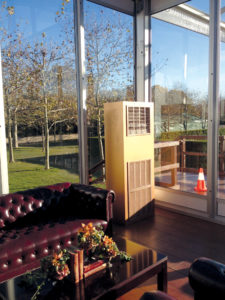
Indeed, the idiom “It’s not the heat, it’s the humidity” is one that event rental companies must emphasize with their clients. “A lot of it has to do with the area of the country that they are in and what kind of relative humidity and temperature they are going to be dealing with during the event,” Boland says. “I have a tent cooling guide that I send [customers] on how to set up evaporative coolers or the tent fans. [The coolers] have oscillating fans on top on them, and one unit can cover 4,800 square feet of unobstructed air. That number helps determine how many a customer needs based on the size of the tent. For traditional air conditioning in a tent, we ask how many people they expect to host and the square footage of the tent.”
Sorenson formulates system size by considering the cubic area inside the tent, the desired interior temperature and how many people will be in the tent. He also recommends asking specific questions about the event. “Does the customer want spot cooling inside the tent or the entire area cooled?” he asks. “What power is available and how much space is there to place the units outside?”
Where does this go?
The placement of climate control equipment within a tent can alter its efficiency. There is no one-size-fits-all guideline for setting up equipment for a tented event, but there are some basic rules that can help event professionals get the most out of their systems.
“We work with a venue manager, the caterer and the hosts to get a clear understanding of how the space will be used,” Behnke says. “Every tent is different and every event is different. Our units are modular, so we can move them if we need to, even during an event.”
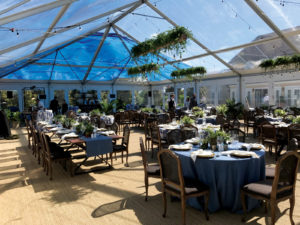
A flexible climate control system allows event rental companies to keep up with an event in real time and make adjustments that keep clients happy and cool.
“At high-end events, we have moved [units] if an issue arises,” she says. “Sometimes one of the tent walls is being used as a projection screen, or has a wall of graphics on it that we can’t block. One event had a car in the tent and we couldn’t have our units near it [because of] photo ops.”
Boland advises considering wind when deciding where to place equipment in tents with open sides. “We generally suggest a tent fan every 10 to 15 feet,” she says. “If there is a prevailing wind, we suggest that they work with it and have all the tent fans moving in the same direction as the wind. If it’s going to be a closed wall tent, we suggest a racetrack pattern so you’re moving the air around.”
Sorenson recommends trying to keep a low profile with cooling equipment. “Most jobs can be accommodated by using the back side or ends of the tents where traffic is limited,” he says.
To maximize efficiency, Behnke communicates with other vendors and service providers who will also be using the tent. She recommends thinking about it like a home—the more it’s left open, the more air that escapes. “We tell the catering staff and service staff to be mindful of the doors,” she says. “They usually want to keep the tent cool, so they listen to us. We try to put condensing units and cabling out of the general traffic areas where people access the tent.”
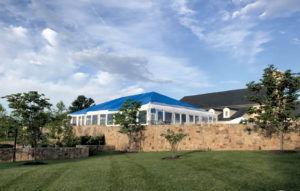 All systems go
All systems go
Even the best-laid plans can change when weather threatens an event or more people than expected show up. AirPac takes a direct, low-risk approach to managing equipment at events for which the company provides rental units: the company always has a technician on-hand, coming in once the tent is up and monitoring equipment throughout the event.
“We don’t get a ‘do over’ for an event,” Behnke says. “We want to be there at the back end of the tent where everyone else puts their stuff to keep control of our [systems].”
For large and high-profile events, Sorenson recommends pre-event meetings. For smaller events, he advises leaving detailed instructions with customers. “Pick up/drop off [situations] are only for your small events that require only one or two [cooling] units,” he says. “With these, instructions to the customer are very important to determine that the customer knows [how much] power is needed.”
Today’s climate control suppliers offer more options than ever to keep event tents cool and comfortable. With the correct equipment and cooling plan, there is no reason for tented event planners—or their clients and guests—to ever break a sweat.
Jake Kulju is a freelance writer based in Shafer, Minn.
Cooling a tent efficiently and effectively needs to begin long before event attendees arrive.
“We start conditioning the space several hours before people enter the tent,” says Tina Behnke of AirPac® Inc. “If it is a 90-degree day, everything under the tent is 90 degrees too. We come in several hours ahead of time to . . . bring the temperature down and decrease the humidity. If the tent is on grass without flooring, it can be very humid in the summer and we have to pull a lot of moisture out of the air.”
 TEXTILES.ORG
TEXTILES.ORG


